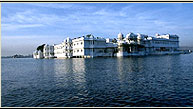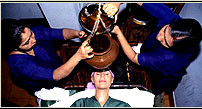-| Amravati | -
Location: District Guntur – (Andhra Pradesh) Lat 80º 17'N,
16º 34'E

On the banks of Krishana river 35 kms. from Guntur, Amarvati - the ancient Dhanyakata
is situated. The place flourished as an important Buddhist centre of art and
culture in Southern India in the third century AD and remained in prominence
till the 13th Century. This historic fact is attested by a large number of inscriptions
found at the site itself. The nucleus of the main stupa called Maha chaitya,
which formed the principal focus of the Buddhist establishment, goes back most
probably to the 3rd century BC. The discovery of a large number of stone and
bronze images of Lord Buddha and also of the stone figures of Buddhist deities
like Maitreys, Manjusari, Lokesvara, Vajrapani, Heruka etc. of the 6th to 11th
century AD testifies the prosperity of the Buddhist art patronized by contemporary
rulers. The period also is marked for the gradual evolution of Buddhism in its
final tantric Vajrapani forum.
The main stupa dome was embellished with slabs of lime stone with beautiful
carving of Jataka stories and scenes from the life of Buddha. Around the base
of the drum and concentric with it was processional path paved with slabs of
gray limestone. The floor was found to be perforated with large number of holes
apparently as a marking of insertion of free standing pillars crowned by Dharama
– Chakra, stupa and other symbols.
Amarvati shows progressive development of style. A progression from simple to
elaborate decoration are manifested in the surviving remains of both the railing
and drum slab. The work on the grey lime slabs to embellish the stupa has no
doubt the highest water mark in the development of art in the Southern Indian
during the 3rd century AD. The majority of the existing votive inscriptions,
however, record the gifts of caved casing slabs, pillars, upright crossbars,
coping stones etc.; offered by hundreds of devotees, monks, nuns, worshipers
from different parts of India belonging to the 2nd century AD, when the mahachaitya
including its railing underwent additions.




